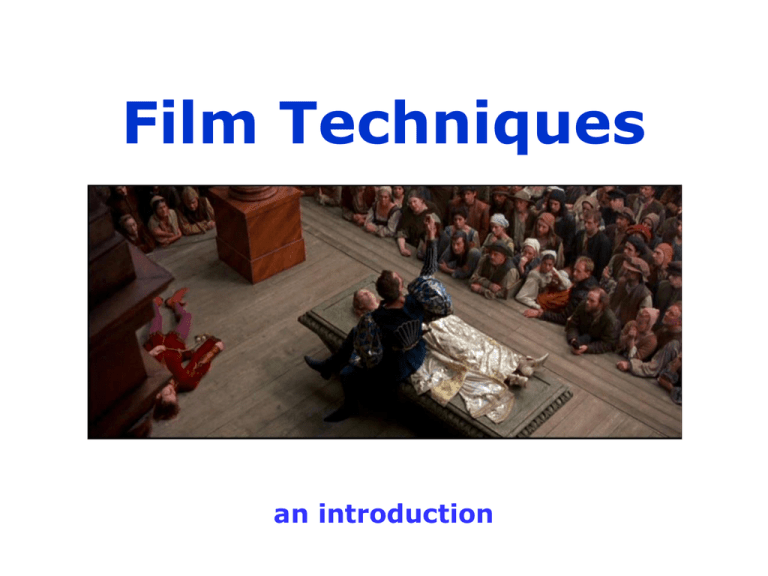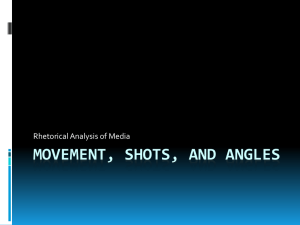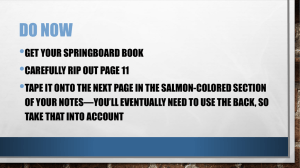File
advertisement

Film Techniques an introduction The drama, the attraction, of film lies not so much in what is shot – that's the drama of subject – but in how it is shot and how it is presented through editing. – James Monaco, How to Read a Film If a writer uses the word 'rose', the reader is free to imagine any of a thousand different possible roses. When a film-maker shows us a rose, we all see the same rose. But we can be told a vast amount about the rose, much more than a writer can tell us, by the way it is filmed – from above close or below, or distant, frontally lit or back-lit, moving or still, in full colour, black and white desaturated colour, or special effect accompanied by music or silence, and so on. Atmosphere can be created, symbolism implied, metaphors intended – all in a brief moment. The possibilities are endless And every image, every frame, of the film will be the result of dozens of decisions about what will be shown – and how. Part 1: Useful Terms mise en scène This refers to all the things that are 'put in the scene', as well as the way that we are shown them. Or, put more technically, it means the arrangement of visual weights and movement within a given space. In live theatre, that space is usually defined by the proscenium arch. In movies, it is defined by the edge of the picture – the frame that encloses the images. Hugh Grant in About a Boy (2002) framing refers to the relationship of the objects in the shot to the frame tight framing is usually used for close shots. The composition is so carefully balanced and harmonised that the people photographed have little or no freedom of movement. MS THREE of Ed Stoppard, Adrien Brody and Frank Finlay in The Pianist (2002) The tight framing underlines the concern of the three at what they are seeing. loose framing usually in longer shots The composition is looser and freer within the confines of the frame so that the people photographed have considerable freedom of movement. A much looser MS THREE shot John Turturro, Tim Blake Nelson and George Clooney in O Brother, Where Art Thou? (2000) The loose framing is appropriate for an open road shot – and also has a more comic tinge. Will Patton and Denzel Washington in Remember the Titans (2000) Adam Goldberg and Anthony Rapp in A Beautiful Mind (2001) loose framing – and a beautifully composed shot which brings us to the rule of thirds for centuries, artists have followed this rule of composition, and photographers and cinematographers have followed suit The rule of thirds divides the frame into thirds both horizontally and vertically. The points where the vertical and horizontal lines cross are aesthetically pleasing spots to place subjects or to have perspective lines converge. Look at the way these shots have been composed with the 'rule of thirds' in mind: Note how each of the two figures is just to the left of a vertical, and how each of the nine segments contains a point of interest. Thora Birch in American Beauty (1999) Thora Birch and Kevin Spacey in American Beauty American Beauty Of course, movement affects composition; characters will not always stay in the same relationship to the frame. when an object is placed centrally, it can become confrontational as in these shots from American Beauty the gun is right at the centre of the frame The other mathematical basis for composition has also been used for hundreds of years. It provided the measurements for the beautiful proportions of ancient Greek Temples: It is variously called the golden section, the golden ratio, the golden mean, or the divine proportion. Without getting into complicated mathematics, it is a proportion based on a ratio of 1:1.618. Although architects no doubt measured, artists, photographers and cinematographers usually use their eyes: it is the most pleasing of proportions as in this superb shot from Atonement (2007): the horizon falls on the Golden Section. Keira Knightley in Atonement Cinematic mise en scène encompasses both the staging of the action and the way it's photographed: set design, costume, props, composition, lighting, and the general visual environment, as well as camera placement and movement, placement of actors, and what they say and do. In fact, everything that takes place on the set prior to the editing process. Kevin Spacey at work in American Beauty Everything in this shot is the result of a decision that has been made: what is on Lester's desk, the placement of his desk, what he is wearing, how he is sitting, what he is saying, the light and colour and so on. It all comes under the label of mise en scène. In this scene from American Beauty, Thora Birch is seated back in the picture space – the table and objects in front of her separate her from her parents as a visual metaphor of the emotional gap between them. Buttercup (Robin Wright), on the other hand, is comfortable in her home which encloses her and surrounds her. The Princess Bride (1987) Paul (Matthew Macfadyen) is far from comfortable visiting his brother after a long absence. In My Father's Den (2004) His stance is unrelaxed, the composition is unbalanced and the frame seems to press down on the top of his head. The different aspect ratios emphasise the difference… … which is why films need to be seen in the appropriate ratio. Everything in the frame is there for a purpose. The two boys in this shot from Remember the Titans are talking to each other because they have to. The distance between them underlines their mutual hostility, and the scene is set against the stunning architectural background which subtly evokes the entrenched racism of the establishment. The representation of space affects the reading of a film. deep space when significant elements of an image are positioned both near to and distant from the camera these objects do not all have to be in focus Gandalf leaves the Shire in The Fellowship of the Ring Jess joins the practice in Bend It Like Beckham (1999) In shallow space the image is staged with very little depth. Truman is trapped between a wall and two insistent characters, with a hint of depth (and freedom) tantalisingly shown to one side. The figures in the image occupy the same or closely positioned planes, as in this shot also from The Truman Show (1998) Holland Taylor, Jim Carrey, Laura Linney again, the metaphor of being trapped is powerfully created by the shallow space. Shallow space can be staged, as this is; or it can be achieved optically, with the use of a telephoto lens, as in this shot from Spider-Man: the telephoto lens reduces the distance between his own house and that of the girl Peter Parker yearns for Here the shallow space – created by wall and door – added to the mesh in front creates an almost flat effect – an effective metaphor for the way this character is trapped in her own world. Mirando Otto plays an agoraphobic in In My Father's Den. the deep space behind her son, however, creates a quite different effect Deep space in the opening shot of The Player (1992)… followed almost immediately – within the same tracking shot – by this very shallow space, with Tim Robbins hemmed in by the window and the wall of his office. This shot from American Beauty brilliantly achieves both effects in one frame. On the right, Wes Bentley stands with his camcorder in shallow space; on the left, the TV screen shows what he is filming, and so creates the illusion of deeper space. A wide shot does not refer to the actual width of the shot, since the frame width cannot alter. It refers more to the content and purpose of the shot. A wide shot [WS] gives a broad view of an area, and conveys scale, distance, and geographic location. Extreme wide shots [EWS] are often used as establishing shots; they often have great depth as well: Hobbiton, in The Fellowship of the Ring Bilbo's birthday party Lars and the Real Girl (2007) Little Miss Sunshine WIDE EST. SHOTS can be of interiors also, as these two shots from V for Vendetta (2005) illustrate: Evey (Natalie Portman) is shot in LS but the purpose of the shot is to show her within her room, so it is better described as a WIDE (or an LS WIDE) Another EWS shows the home that V has made for himself in a forgotten crypt. establishing shot/re-establishing shot sometimes it takes more than one shot to set up a scene In the initial sequence of Peking Opera Blues (1986), director Tsui Hark uses three shots to establish the locale. Three musicians are shown against a fireplace in what looks like a luxurious room. the second establishing shot shows us the other half of the room – shot/reverse shot – and reveals a party going on. After several close ups, a third establishing shot – a re-establishing shot - shows once again the spatial relationships introduced with the establishing shots.









